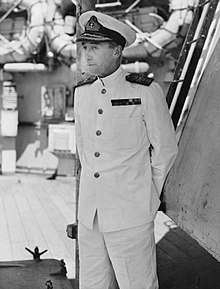Bernard Rawlings (Royal Navy officer)
Admiral Sir Henry Bernard Hughes Rawlings, GBE, KCB (21 May 1889 – 30 September 1962) was a Royal Navy officer who served as Flag Officer, Eastern Mediterranean during the Second World War.
Sir Bernard Rawlings | |
|---|---|
 Vice Admiral Rawlings during the Second World War | |
| Born | 21 May 1889 St Erth, Cornwall, England |
| Died | 30 September 1962 (aged 73) Bodmin, Cornwall, England |
| Allegiance | United Kingdom |
| Service/ | Royal Navy |
| Years of service | 1904–1946 |
| Rank | Admiral |
| Commands held | Eastern Mediterranean (1943–44) West Africa Station (1943) Force B (1941) 7th Cruiser Squadron (1941) 1st Battle Squadron (1940–41, 1944–45) HMS Valiant (1939–40) HMS Delhi (1932–34) HMS Curacoa (1932) HMS Active (1931–32) |
| Battles/wars | First World War Second World War |
| Awards | Knight Grand Cross of the Order of the British Empire Knight Commander of the Order of the Bath Mentioned in Despatches (2) Legion of Merit (United States) Order of George I (Greece) War Cross (Greece) |
Naval career
Rawlings was born in St Erth, Cornwall, England, on 21 May 1889.[1] Following education at Stubbington House School, Rawlings joined the Royal Navy in 1904 and served in the First World War.[2] After the war he worked for the Foreign Office and undertook Military Missions in Poland.[2] He then commanded the destroyer HMS Active and then the cruisers HMS Curacoa and HMS Delhi before becoming Naval Attaché in Tokyo in 1936.[2]
Rawlings served in the Second World War, initially commanding the battleship HMS Valiant, then commanding the 1st Battle Squadron from 1940 before commanding the 7th Cruiser Squadron from 1941 and becoming Assistant Chief of Naval Staff in 1942.[2] He became Flag Officer, West Africa in 1943 and Flag Officer, Eastern Mediterranean in 1943.[2] He went on to be second-in-command of the British Pacific Fleet with his flag in HMS King George V.[3] He commanded British Task Force 57 in the Pacific from 1944 through the Battle of Okinawa in the spring of 1945,[4] and retired in 1946.[2]
Rawlings died in Bodmin, Cornwall, England, on 30 September 1962.[1]
References
- uboat.net Sir Henry Bernard Rawlings OBE, RN
- Liddell Hart Centre for Military Archives
- National Maritime Museum Archived 1 September 2010 at the Wayback Machine
- Stevens, Mike (27 March 2005). "What my Dad Did for Us in the War". WW2 People's War. BBC.
| Military offices | ||
|---|---|---|
| Preceded by Sir Algernon Willis |
Flag Officer, Eastern Mediterranean (formerly Commander-in-Chief, Levant) 1943–1944 |
Post disbanded |